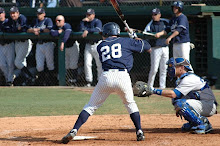Wednesday, April 15, 2009
The Pre-Game Meal
The meal should be high in starch, which breaks down more easily than protein and fats. The starch should be in the form of complex carbohydrates (breads, cold cereal, pasta, fruits and vegetables). They are digested at a rate that provides consistent energy to the body and are emptied from the stomach in two to three hours.
High-sugar foods lead to a rapid rise in blood sugar, followed by a decline in blood sugar and less energy. In addition, concentrated sweets can draw fluid and contribute to dehydration, cramping. Don't consume any carbohydrates one and a half to two hours before an event. This may lead to premature exhaustion in endurance events.
Pre-Event Meal Plan 1
Milk, skim - 1 cup
Lean meat or equivalent - 2 ounces
Fruit - 1 serving (1/2 cup)
Bread or substitute - 2 servings
Fat spread - 1 tp
Pre-Event Meal Plan II(approximately 900 calories)
Milk, skim - 2 cups
Cooked lean meat or equivalent - 2 ounces
Fruit - 1 serving (1/2 cup)
Pasta or baked potato - 1 cup or 1 medium
Bread or substitute - 2 servings
Vegetable - 1 serving (1/2 cup)
Fat spread - 1 teaspoon
Dessert: Angel food cake or plain cookies - 1 piece 2 cookies
Tuesday, April 14, 2009
Nutrition for Athletes
proper running form and tips and exercises
Running form is a critical part of running performance and injury prevention. Correct running form and running mechanics will make your a more efficient runner and will improve your running efficiency. You will run easier, faster and farther with proper running form. Poor running form will slow you down, decrease your efficiency and can even be the cause of many running injuries. Here you will find running form tips, advice, articles and information to help you improve your running form, increase your running performance, avoid injuries and become a more economical runner.
-Quick Feet
Begin by performing a slow jog. Using a short stride and bouncing on your toes, raise your knees as high as possible on each stride. Concentrate on decreasing the time of contact between your foot and the ground. As soon as your foot hits the ground, quickly spring if off of the ground and into the high knee position. There will be little forward distance covered, but keep moving forward. Repeat for 30 to 50 meters. Repeat for the desired number of repetitions.
-High Knees
Begin by performing a slow jog. Using a short stride and bouncing on your toes, raise your knees as high as possible on each stride. Concentrate on raising your knees as high as possible. There should be little forward distance covered, but keep moving forward. Repeat for 30 to 50 meters. Repeat for the desired number of repetitions
-Straight legs
Run forward keeping the legs straight. Forward speed is not important. Focus on quickly bringing the legs back under the body. Arms are held in normal running position.
-Kick Outs
Similar to the straight legs drill, except the knee is brought up and the lower leg is kicked out and then the whole leg is brought quickly under the body.
-Bounding
Running tall, extend the push off phase and bound. I use a mental image of a deer for this one. Relax shoulders and be sure to use arms as part of the drive phase.
